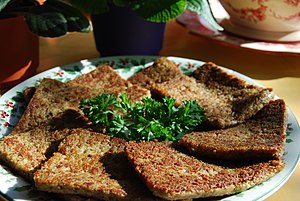Livermush

Livermush is a Southern United States pork food product prepared using pig liver, parts of pig heads, cornmeal and spices. It is a regional cuisine that is common in Western North Carolina, and is typically consumed as a breakfast and lunch food. It has been suggested that livermush derives from scrapple. By law in North Carolina, the product must consist of at least 30% pig liver. Several festivals exist in North Carolina that are dedicated to the food.
Though sometimes considered the same as liver pudding, livermush generally contains more cornmeal and is coarser in texture.[1] It is generally prepared using a different recipe compared to liver pudding,[2] though the distinction can be blurred.[3] For example, sometimes livermush is referred to as "liver pudding".[3]
Overview
Livermush is composed of pig liver, pig head parts such as snouts and ears, cornmeal and seasonings.[1][2][4] It is commonly spiced with pepper and sage.[1] The meat ingredients are all cooked and then ground, after which the cornmeal and seasoning is added.[5] The final mixture is formed into blocks which are then refrigerated.[5] It typically has a low fat content and a high protein content.[4]
It is a regional cuisine that is commonly found in the western part of North Carolina, as well as being noticeably present in central North Carolina.[3][6][7] It is also consumed in other parts of the state, and is available in some areas in other states as well, such as Georgia, Virginia and areas in Florida.[1] Livermush is mass-produced by two Shelby, North Carolina meat packing companies, Jenkins Foods and Mack’s Liver Mush and Meat Co., who distribute it to various states.[1][8]
It is cooked by cutting a slice off of a premade loaf and frying it.[4][9] At breakfast it is served alongside grits and eggs.[1] For lunch it can be made into a sandwich with mayonnaise, grape jelly[10] or mustard, either fried, or left cold.[3] As livermush's popularity has risen, it has appeared as an ingredient in dishes such as omelettes and pizzas.[11][12][13]
History
It has been suggested that livermush derives from scrapple, and likely originated from German settlers who traveled south through the Appalachian mountains in the 1700s.[4][3] In the 1930s and 1940s, a five-pound portion of livermush cost around 10 cents.[4] Today, by law in North Carolina, genuine livermush must consist of at least 30% pig liver.[4][9]
Events
Shelby, North Carolina hosts an annual Livermush Exposition, which began in 1987 to celebrate the unique delicacy.[4] In that year the Cleveland County Commissioners and the Shelby City Council passed resolutions proclaiming that "livermush is the most delicious, most economical and most versatile of meats."[2] Other towns in North Carolina that have livermush festivals include Drexel and Marion.[14]
See also
References
- ^ a b c d e f Clevenger, Kelli H. (11 January 2016). "The Liver Mush Mystique". Paste. Retrieved 5 January 2020.
- ^ a b c Poteat, Bill (18 August 2018). "Livermush victim of hateful prejudice". The Gaston Gazette. Retrieved 5 January 2020.
- ^ a b c d e Deutsch, J. (2018). We Eat What? A Cultural Encyclopedia of Unusual Foods in the United States. ABC-CLIO. p. 203. ISBN 978-1-4408-4112-5. Retrieved 5 January 2020.
- ^ a b c d e f g C. Davis, Timothy (22 December 2004). "North Carolina goes hog wild over livermush". The Christian Science Monitor. Retrieved 5 January 2020.
- ^ a b "Cook’s Corner: Livermush well-known in some parts of South". February 4, 2014. Athens Banner-Herald. Retrieved 5 January 2020.
- ^ Karon, J.; McIntosh, M. (2004). Mitford Cookbook & Kitchen Reader. A Mitford Novel Series. Viking. p. 56. ISBN 978-0-670-03239-6. Retrieved 5 January 2020.
- ^ Rhew, Adam (16 September 2016). "In North Carolina, Livermush Still Wins Hearts". Eater. Retrieved 5 January 2020.
- ^ Orlando, Joyce (16 October 2019). "Mush, Music and Mutts kicks off Saturday in Shelby". The Shelby Star. Retrieved 5 January 2020.
- ^ a b Frye, J. (2014). Moon North Carolina. Moon Handbooks. Avalon Publishing. p. 411. ISBN 978-1-61238-603-4. Retrieved 5 January 2020.
- ^ Evans, Bill (31 May 2019). "Carolina Moment: Liver Mush, history to be celebrated". WLOS. Retrieved 4 January 2020.
- ^ Bashor, Melissa W. (23 February 2015). "Kings of Livermush". Our State. Retrieved 1 August 2015.
- ^ "Our Products". Neese's Country Sausage. Retrieved 1 August 2015.
- ^ "Cook's Corner: Livermush well-known in some parts of South". Athens Banner-Herald. 3 February 2014. Retrieved 1 August 2015.
- ^ Taylor, Charles H. (13 October 1993). "Livermush: Part of Western North Carolina's History (by Michael Goforth) (Extension of Remarks)". The Library of Congress. Retrieved 6 December 2010.
External links
- Shuford, Chuck (6 November 2007, updated November 11, 2018) "What Happened to Poor Man’s Paté". The Daily Yonder.
